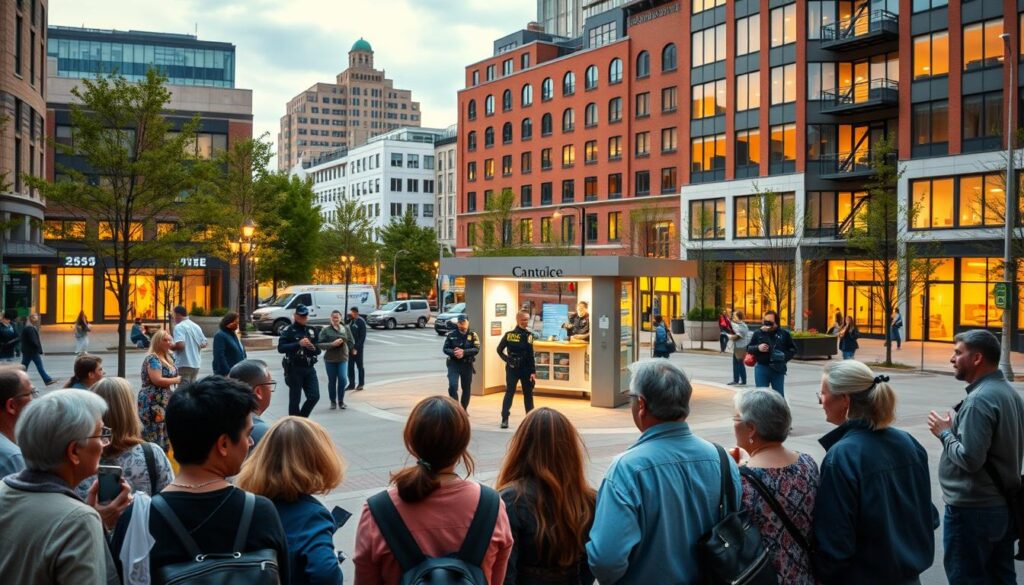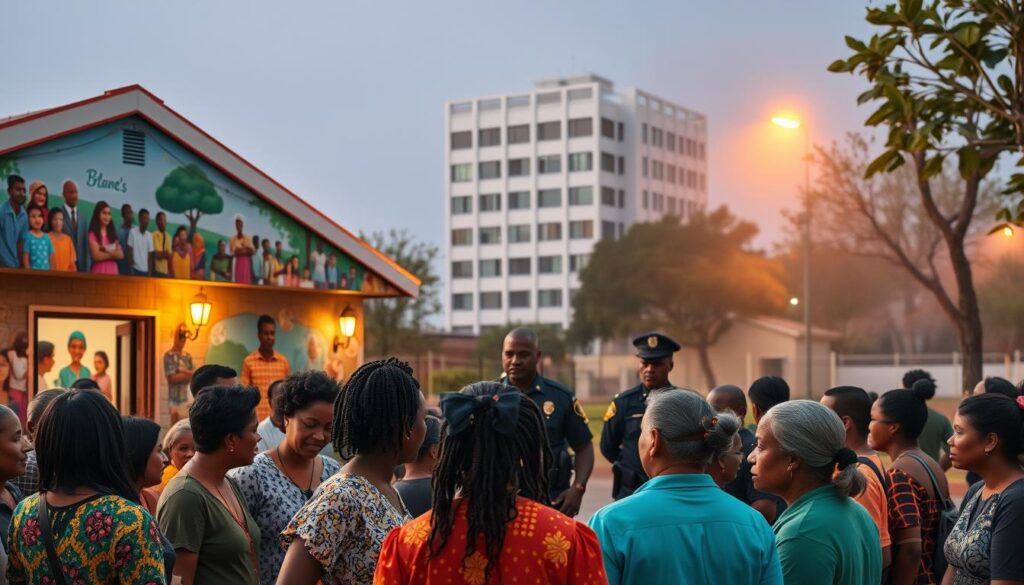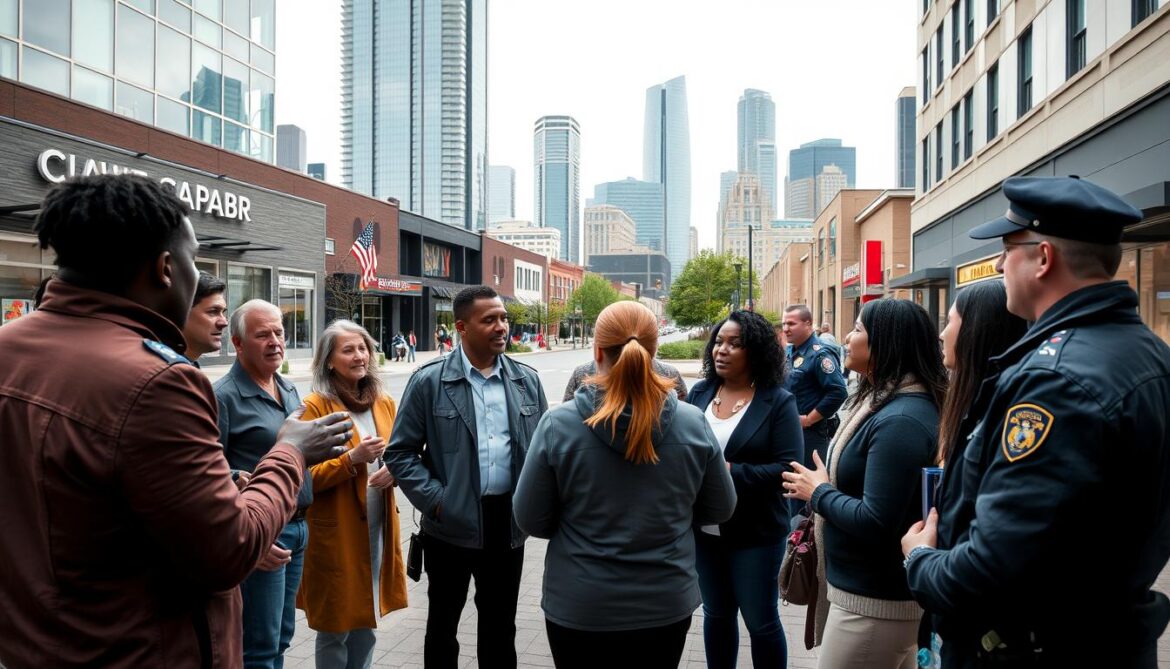Did you know every dollar invested in preventative measures saves seven dollars in justice system costs? This eye-opening statistic drives Canada’s nationwide strategy to build safer neighbourhoods through collaboration, not just enforcement.
Across provinces, municipalities work together through networks like the Canadian Municipal Network on Crime Prevention. Their focus? Tackling root causes of harmful behaviour before incidents occur. You’ll see how this approach combines data-driven solutions with local insights to address unique challenges in urban and rural areas alike.
What makes this system stand out? Instead of relying solely on policing, it brings together government agencies, non-profits, and residents. You’re part of the solution through community programs that foster trust and opportunity. Recent results show regions adopting these methods report fewer incidents and stronger social connections.
By prioritizing early intervention and shared responsibility, Canada’s model demonstrates how strategic investments create lasting change. You’ll discover how this framework balances immediate safety needs with long-term societal benefits – all while keeping taxpayer dollars efficient.
Overview of Canada’s Approach to Crime Prevention
Canada tackles public safety by nurturing potential in citizens and spaces alike. This dual strategy combines human-centered programs with smarter urban planning to address challenges at their source.
Emphasising Social Development and Community Safety
Crime Prevention through Social Development (CPSD) helps build resilient neighbourhoods by supporting families and schools. You’ll see programs teaching life skills, conflict resolution, and career readiness – tools that empower people to avoid harmful situations.

Educators and local leaders work together to create safe spaces for youth development. This approach recognizes that stable relationships and opportunities often prevent problems before they start.
Integrating Environmental Design in Public Spaces
Ever notice how bright lighting or clear sightlines make parks feel safer? That’s Crime Prevention through Environmental Design (CPTED) in action. Urban planners use natural surveillance principles to design areas where community activity naturally deters risky behaviour.
Simple changes like trimmed bushes near sidewalks or visible building entrances make public zones less appealing for opportunistic acts. These strategies work best when residents help maintain shared spaces – turning design theory into daily practice.
Implementing the Crime Reduction Initiative Across Canada
How do diverse groups across Canada unite to create safer neighborhoods? The answer lies in partnerships that span municipal borders through networks like the Canadian Municipal Network on Crime Prevention (CMNCP). Toronto’s involvement showcases how cities share resources and strategies to address local challenges while aligning with national goals.
Collaborative Efforts with Local Stakeholders
Municipal leaders, law enforcement, and residents jointly develop safety plans tailored to their area’s unique needs. This teamwork ensures strategies respect cultural values while addressing pressing concerns. For instance, rural towns gain access to urban-developed tools through CMNCP knowledge-sharing platforms.

Regular meetings between stakeholders help adjust approaches based on real-time feedback. Police departments might train community groups in conflict resolution, while nonprofits connect vulnerable populations with support services.
Community-Based Programs and Services
Neighborhood-led efforts form the heart of Canada’s strategy. Youth mentorship programs in Winnipeg and job training workshops in Halifax demonstrate locally designed solutions. These initiatives empower citizens to lead safety improvements while receiving guidance from provincial experts.
Success stories reveal increased public trust and participation where residents co-manage projects. By combining grassroots creativity with structured support, communities build lasting protective networks that adapt as needs evolve.
Crime Prevention Strategies and Data Insights
What transforms a reactive safety plan into a proactive shield? Canada’s answer lies in blending real-world insights with adaptable methods. By focusing on measurable outcomes, communities refine their tactics to stay ahead of emerging challenges.
Utilising Evidence-Based Data for Prevention
Data-driven decision-making identifies patterns like seasonal spikes in conflicts or neighbourhood-specific risk factors. Analysts map hotspots using police reports, social services referrals, and community surveys. This precision allows towns to deploy outreach teams exactly where tensions simmer.

Take Situational Prevention (SCP) – it examines how environments influence behaviour. For example, poorly lit alleys might see fewer incidents after installing motion-activated lights. Crisis phone lines and mediation committees then address underlying disputes before escalation.
Innovative Approaches and Localised Solutions
Communities merge tech tools with grassroots wisdom. Vancouver’s pilot program combines anonymized incident data with resident feedback to adjust patrol routes weekly. Rural areas use mobile apps to report concerns instantly, bridging gaps in traditional systems.
Three key advantages emerge:
- Tailored responses for urban density vs. remote regions
- Real-time adjustments using predictive analytics
- Shared learnings that strengthen national frameworks
These methods prove prevention isn’t one-size-fits-all. When local insights fuel broader strategies, everyone benefits from smarter resource use and lasting safety gains.
Funding, Support, and Resources for Crime Prevention
What fuels safer neighborhoods across Canada’s diverse regions? Strategic financial backing transforms ideas into action. The federal government channels funding through departments like Justice and Correctional Services, empowering communities to lead safety efforts tailored to their needs.

Understanding the Role of Government Funding
Each year, targeted resources flow to local groups through mechanisms like the Crime Prevention Fund. This stream supports community-led projects fostering social connections and safer public spaces. You’ll find initiatives range from youth mentorship to neighborhood watch tech upgrades.
Allocation processes prioritize areas with higher vulnerability while encouraging innovation. Successful programs often become blueprints for other regions. Teams receive not just money but expert guidance – from designing evaluations to securing long-term sustainability.
Beyond dollars, assistance includes training workshops and equipment access. Imagine volunteers learning conflict resolution techniques or towns installing better lighting using shared resources. These investments build local capacity to address challenges proactively.
Ongoing support ensures effective projects expand their reach. Evaluation tools help communities measure impact and refine approaches. This cycle keeps services responsive to changing needs while maximizing every dollar’s value.
Future Directions and Innovative Approaches in Crime Prevention
Canada’s safety blueprint now prioritizes tomorrow’s solutions through technology and intergenerational partnerships. This forward-thinking mindset transforms prevention from temporary fixes into lifelong community habits.

Embracing Technology and Training in Law Enforcement
Police departments now use body cameras paired with AI analysis to de-escalate conflicts faster. You’ll see officers trained in virtual reality simulations that recreate high-pressure scenarios safely. These tools improve decision-making while building public trust through transparency.
Real-time data sharing between agencies helps identify emerging patterns. Predictive analytics guide patrol routes, while community apps let residents report concerns instantly. This tech shift creates proactive strategies that address risks before they escalate.
Engaging Youth and Promoting Justice Initiatives
Schools and community centres launch mentorship projects where teens lead safety campaigns. Through art programs and sports leagues, young people gain leadership roles that strengthen neighbourhood bonds. One Halifax project teaches coding skills while addressing local safety challenges.
Restorative justice programs now focus on repairing harm through dialogue rather than punishment. You’ll find youth councils advising municipal leaders on policy changes. These approaches nurture responsibility while creating tangible improvements in communities.
Three key shifts define Canada’s path forward:
- Integration of prevention principles into education systems
- Co-designed solutions with young citizens at the table
- Tech tools that empower rather than surveil
By treating safety as a shared lifestyle instead of isolated efforts, these methods build resilience across generations. When communities invest in youth potential and smart strategies, everyone gains lasting protection.
Conclusion
Canada’s path to safer communities reflects a fundamental shift in how societies address harmful behaviour. By treating safety as shared responsibility, efforts focus on root causes through education, urban design, and social supports rather than reactive measures. The Department of Justice mandates this approach, aiming to reduce victimization while fostering neighbourhood trust.
Local partnerships between residents, agencies, and stakeholders create crisis intervention frameworks that resolve tensions before escalation. These methods align with insights from understanding hate crime trends and prevention, showing how addressing social divides strengthens community bonds.
Investments in prevention yield measurable benefits: every dollar spent on early support saves seven in justice costs. This approach builds resilience by empowering people through opportunity, not enforcement. When communities unite around shared goals, they craft lasting safety – one connection at a time.

